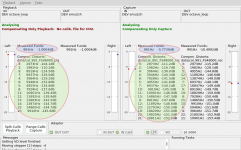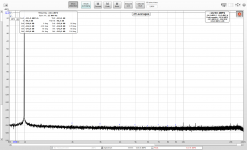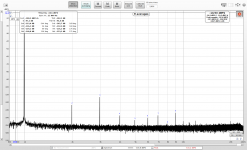Just wanted some advice about which direction to go in for improving my THD+N measurements. i.e. What is the next step?
Current Setup:
Focusrite 2i2 as is. No mods, no external oscillators, no level matching interfaces, no protection, no buffers.
Goals:
To measure as low as possible on a hobbyist budget. Hopefully something that can start to get a feel for how well Tom's modulus 86 composite amplifier boards are performing or at least move me further in that direction.
Things like the QA401 are a good option. But I'd like to do better if possible on a hobbyist budget. Instead of spending money on the QA401 are there better solutions?
Ideas:
Output buffer (I need 2V to measure amplifiers. Distortion from the output is a limiting factor for the 2i2)
Precision oscillators
Notch filters
Cordell distortion analyser
Get a different interface or DAC? Khadas tone board?
Are there dedicated ADC cards that are affordable with very low noise?
Can someone also advise what projects are active for level matching and input protection?
I don't think boards are currently available for Peter millet soundcard interface, linear audio autoranger or cordell distortion magnifier. Are there any active projects to improve the functionality and or performance of soundcards.
Where would you spend the time/money if you wanted to get improve upon a soundcard interface? I appreciate any advise
Current Setup:
Focusrite 2i2 as is. No mods, no external oscillators, no level matching interfaces, no protection, no buffers.
Goals:
To measure as low as possible on a hobbyist budget. Hopefully something that can start to get a feel for how well Tom's modulus 86 composite amplifier boards are performing or at least move me further in that direction.
Things like the QA401 are a good option. But I'd like to do better if possible on a hobbyist budget. Instead of spending money on the QA401 are there better solutions?
Ideas:
Output buffer (I need 2V to measure amplifiers. Distortion from the output is a limiting factor for the 2i2)
Precision oscillators
Notch filters
Cordell distortion analyser
Get a different interface or DAC? Khadas tone board?
Are there dedicated ADC cards that are affordable with very low noise?
Can someone also advise what projects are active for level matching and input protection?
I don't think boards are currently available for Peter millet soundcard interface, linear audio autoranger or cordell distortion magnifier. Are there any active projects to improve the functionality and or performance of soundcards.
Where would you spend the time/money if you wanted to get improve upon a soundcard interface? I appreciate any advise
I will be interested to see what suggestions come up, I'm trying to figure out the same. Just picked up a motu m4, and some resisters for a dummy load. I have a Khadas tone board on an EdgeV SBC, which could become a test rig running Ubuntu, will have to compare with the Motu and Windows. Still need to figure out the remaining bits.
Imho, the simplest start is:
REW
10:1 and 100:1 cheap ebay probes, with metal connector interfaces (eg. BNC to RCA, RCA to 6.5mm)
12V DC powered cheap audio amp pcb assembly (capacitor coupled output with non-isolated 0V level input/output), with 12V SLA battery (eg. 4-7Ah)
You can then couple to reasonably high audio voltages from an amplifier, and can drive any amplifier input.
If you need to characterise how low the distortion is from a DUT, then you can use a test frequency with modified harmonics (using REW), such that a loopback test (without DUT) via the audio amp pcb and 10:1 probe gives nulled harmonic levels. This technique effectively removes your 2i2, and audio amp pcb, harmonic distortion contributions, and so drives your DUT with effectively a zero distortion single frequency source.
So for a couple of dollars, and your 2i2, you get to see what is really important when setting up DUT audio assessments.
REW
10:1 and 100:1 cheap ebay probes, with metal connector interfaces (eg. BNC to RCA, RCA to 6.5mm)
12V DC powered cheap audio amp pcb assembly (capacitor coupled output with non-isolated 0V level input/output), with 12V SLA battery (eg. 4-7Ah)
You can then couple to reasonably high audio voltages from an amplifier, and can drive any amplifier input.
If you need to characterise how low the distortion is from a DUT, then you can use a test frequency with modified harmonics (using REW), such that a loopback test (without DUT) via the audio amp pcb and 10:1 probe gives nulled harmonic levels. This technique effectively removes your 2i2, and audio amp pcb, harmonic distortion contributions, and so drives your DUT with effectively a zero distortion single frequency source.
So for a couple of dollars, and your 2i2, you get to see what is really important when setting up DUT audio assessments.
Last edited:
How do you modify the harmonics using REW? I've used the calibration function to try and correct the roll off that the 2i2 has and make a more flat frequency response. It works ok up to 40khz but has to apply a lot of correction to do the full 96khz of bandwidth that the souncard can use.
Do I understand corectly? Are you doing a loopback with the 12V amp connected and then making a custom eq to correct combined distortion of the 2i2 output, 12Vamp and 2i2 input?
Does this work well? what kind of THD% can you achieve?
Can you give an example of what you mean by the cheap amp? Is this something you can buy of ebay?
Do I understand corectly? Are you doing a loopback with the 12V amp connected and then making a custom eq to correct combined distortion of the 2i2 output, 12Vamp and 2i2 input?
Does this work well? what kind of THD% can you achieve?
Can you give an example of what you mean by the cheap amp? Is this something you can buy of ebay?
Having more options for measuring audio than I can count I would say a QA401 will get you further for less money and hassle than any other. Since it has differential input and native 30V in and a distortion residual in the .0004% range its more than adequate to almost any task. The software is constantly getting better and open source if you want to do your own thing. And with the ASIO interface software it works with ARTA (and Virtins and DiAna) so no limitations there.
You can use a sound card with adapters etc. to get pretty close. But you will have software hardware integration to sort out and having to deal with differential input needs etc.
If you need lower you can get there and a stand alone analyzer can be quicker for single point measurements. However you may end up with 6 analyzers etc. as you transfer audiophile nervosa to test equipment nervosa (cautionary warning. . .)
You can use a sound card with adapters etc. to get pretty close. But you will have software hardware integration to sort out and having to deal with differential input needs etc.
If you need lower you can get there and a stand alone analyzer can be quicker for single point measurements. However you may end up with 6 analyzers etc. as you transfer audiophile nervosa to test equipment nervosa (cautionary warning. . .)
The problem is this compensates combined distortions of the whole loop (DAC + ADC) on one side only . Any phase change in the DUT will ruin the compensation.
Attached is my soundcard DAC/ADC separated distortions with DAC at -1dBFS and ADC left channel at -5.7dBFS. When adding +5dB to the ADC left channel, the distortions of DAC and ADC are almost on par.
The three other screenshots show combined distortions (DAC + ADC) compensated on capture side. The spectra are for the right capture channel - the first is the voltage-divider loopback for which the distortion profile was measured - nicely compensated. But then the divider is replaced with a RC filter yielding exactly same output level - the compensation is gone in the wild. The low-pass filter (basically DUT) rotated the DAC harmonics, completely changing the previous combined distortions.
Attached is my soundcard DAC/ADC separated distortions with DAC at -1dBFS and ADC left channel at -5.7dBFS. When adding +5dB to the ADC left channel, the distortions of DAC and ADC are almost on par.
The three other screenshots show combined distortions (DAC + ADC) compensated on capture side. The spectra are for the right capture channel - the first is the voltage-divider loopback for which the distortion profile was measured - nicely compensated. But then the divider is replaced with a RC filter yielding exactly same output level - the compensation is gone in the wild. The low-pass filter (basically DUT) rotated the DAC harmonics, completely changing the previous combined distortions.
Attachments
Yes the benefit would be when the DAC and any 'signal booster' prior to the DUT had significant harmonic distortion, and the ADC contributed relatively little to the compensation required (eg. if the ADC had a sweet spot or wasn't the weak link).
I will echo what Demian said earlier. Its very easy to get caught up with the test equipment upgrade bug and wind up with a lot of test gear sitting around. One thing I will say is don't settle for one piece of equipment because its a little cheaper and does most of what you want. In the end you'll be wishing you had spent a little more and bought the equipment that checked all of the spaces.
I originally had a QA400 and an HP334. The 334 wouldn't measure low enough for me and the 400 didn't have enough output to drive many amp's to clipping so I upgraded to an HP 339A. Then I got tired of using the bottom of the range on the 339 so I bought an Amber 3501 with the integrated freq meter. This served me well but I got tired of not being able to just run and store tests automatically and the lack of an automated autoranger for the QA400 also sucked. So I finally succumbed and bought an older AP system.
The QA401 is a great option and as long as it meets your criteria it should be on top of your list.
I see the sound card interfaces show up in the diyaudio swap meet. If your diligent in watching you should be able to pick one of those up. I seem to remember a couple of the P Millet interfaces showing up recently but they sell fast.
Also,
I have found that the pricing of used test equipment on the big auction site is extremely cyclical. Over the period of say 12 months or more you'll be surprised how much vintage equipment pricing can cycle. This is especially true when a lot of the systems show up at the same time as it starts driving the average pricing down.
I only mention this because it sounds like you're in no hurry.
I am now using an AP Sys One 22A and its amazing how good of a deal you can get on something like this if you are patient and educate yourself well on the target equipment then sit back and watch the used market. I pieced my current AP system together for about $500. That's a well optioned base AP system and the computer with APWIN software to control it. Its not state of the art, but in combination with a sound card (I use the QA400) it does everything I want and will easily measure down to -100dB THD+N in the 20 - 20k audio band. The last time I checked the loopback performance of it at 1kHz was around .0004% with 80kHz bandwidth.
The nice thing about these older analog systems is that they can be the front end autoranger for your sound card.
Be aware that anything vintage that you purchase may require refurbishment work to get the most out of it. Luckily there's a lot of folks on the forum here to assist with most of these older systems if you choose to go that route.
I originally had a QA400 and an HP334. The 334 wouldn't measure low enough for me and the 400 didn't have enough output to drive many amp's to clipping so I upgraded to an HP 339A. Then I got tired of using the bottom of the range on the 339 so I bought an Amber 3501 with the integrated freq meter. This served me well but I got tired of not being able to just run and store tests automatically and the lack of an automated autoranger for the QA400 also sucked. So I finally succumbed and bought an older AP system.
The QA401 is a great option and as long as it meets your criteria it should be on top of your list.
I see the sound card interfaces show up in the diyaudio swap meet. If your diligent in watching you should be able to pick one of those up. I seem to remember a couple of the P Millet interfaces showing up recently but they sell fast.
Also,
I have found that the pricing of used test equipment on the big auction site is extremely cyclical. Over the period of say 12 months or more you'll be surprised how much vintage equipment pricing can cycle. This is especially true when a lot of the systems show up at the same time as it starts driving the average pricing down.
I only mention this because it sounds like you're in no hurry.
I am now using an AP Sys One 22A and its amazing how good of a deal you can get on something like this if you are patient and educate yourself well on the target equipment then sit back and watch the used market. I pieced my current AP system together for about $500. That's a well optioned base AP system and the computer with APWIN software to control it. Its not state of the art, but in combination with a sound card (I use the QA400) it does everything I want and will easily measure down to -100dB THD+N in the 20 - 20k audio band. The last time I checked the loopback performance of it at 1kHz was around .0004% with 80kHz bandwidth.
The nice thing about these older analog systems is that they can be the front end autoranger for your sound card.
Be aware that anything vintage that you purchase may require refurbishment work to get the most out of it. Luckily there's a lot of folks on the forum here to assist with most of these older systems if you choose to go that route.
FWIW I have two AP system 1's for sale and a switcher and the external DC meter. I'll take any reasonable offers. I need the space.
I suspect that if the QA401 were available KC above may not have gone down that other route. I designed an external interface to extend the QA400 to address some of the issues. However Matt released the QA401 just as I had the prototype mostly working.
I have learned a lot and have found getting the best from these various devices really interesting learning BUT to get useful work done I would look to the quickest road to results.
I suspect that if the QA401 were available KC above may not have gone down that other route. I designed an external interface to extend the QA400 to address some of the issues. However Matt released the QA401 just as I had the prototype mostly working.
I have learned a lot and have found getting the best from these various devices really interesting learning BUT to get useful work done I would look to the quickest road to results.
- Home
- Design & Build
- Equipment & Tools
- Upgrading my THD+N measurement system



